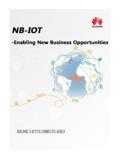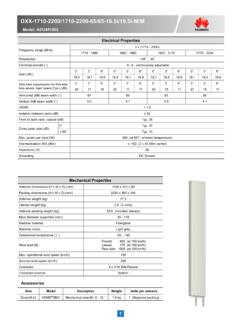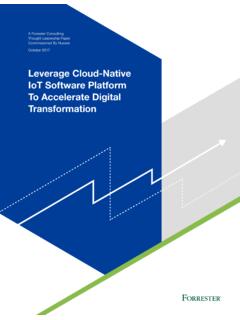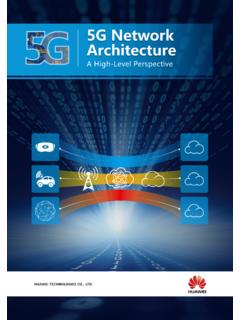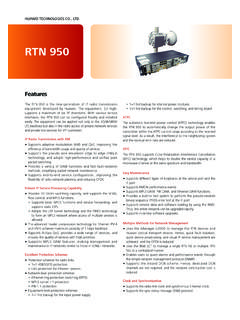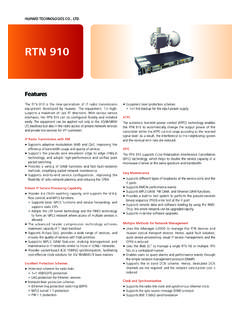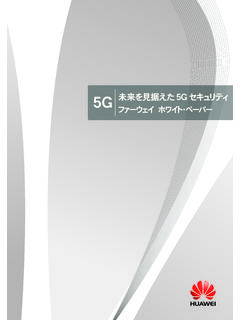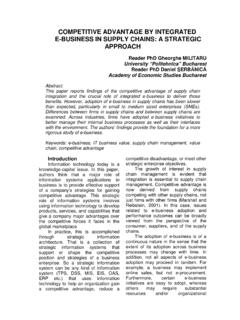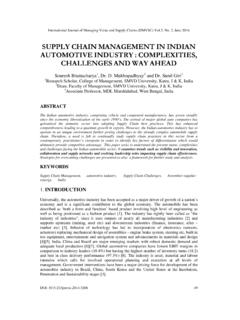Transcription of Table of Contents - huawei.com
1 Table of Contents 1. Emerging Market for Low Power Services and Applications 4 IoT development & Growing Demand for LPWA 4 NB-IoT Use Cases & Market Potential 5 2 Emerging Low Power Technologies 6 Introduction to NB-IOT (Best Solution For LPWA ) 6 The NB-IOT deployment scenarios 7 Low band, an excellent choice for fast deployment 8 3. Shaping the Business model 9 Value Chain and Partnerships 9 Business Potential & Revenue model 10 Summary 10 4 IOT Use case 11 IOT Public 11 IOT Industry 13 IOT Appliance 15 IOT Personal 16 5 Operator Reference Cases 18 Smart Parking 18 Smart Metering 19 Pet Tracking 20 6 Glossary 22 Executive Summary The LPWA market has existed for about 10 years; it s not a new thing. The current technologies (solutions) supporting this market are fragmented and non-standardized, therefore there are shortcomings like poor reliability, poor security, high operational and maintenance costs.
2 Furthermore, the new overlay network deployment is complex. NB-IOT overcomes the above defects, with all the advantages like wide area ubiquitous coverage, fast upgrade of existing network, low-power consumption guaranteeing 10 year battery life, high coupling, low cost terminal, plug and play, high reliability and high carrier-class network security, unified business platform management. Initial network investment may be quite substantial and superimposed costs are very little. NB-IOT perfectly matches LPWA market requirements, enabling operators to enter this new field. NB-IOT enables operators to operate traditional businesses such as Smart Metering, Tracking, by virtue of ultra-low-cost ($ 5 ) modules and super connectivity (50K / Cell), also opens up more industry opportunities, for example, Smart City, eHealth. NB-IOT makes it possible for more things to be connected, but also managing the commercial value of the resulting Big Data is a big task, operators can carry out cooperation with related industries, in addition to selling connections, they can also sell data.
3 1. Emerging Market for Low Power Services and Applications IoT development & Growing Demand for LPWA The Internet of Things IoT has moved from fiction to reality. By 2020, there will be over 14 billion network-enabled devices, according to the International Energy Agency. This compares to approximately billion people using the internet. IoT dramatically widens the internet s scope from people-operated computers towards autonomous smart devices. Often, these devices are connected to the internet for remote diagnostics & control, leading to cost savings. In addition, innovative IoT hardware & services can generate new revenues for example, connected glasses used for industrial applications, more efficient logistics serving new market segments, or industrial appliances sold in a per-usage business model. In many cases, business users & private users can control their IoT application through existing smartphones and tablets, through mobile applications that interact with web servers which the connected objects connect to.
4 Many mobile operators have set up dedicated IoT/M2M business units in order to serve the growing number of companies looking to embrace the business benefits that mobile IoT brings. Larger operators have even made acquisitions so that they can serve a wider part of the value chain and capture revenues beyond pure connectivity. As the market grows, it is becoming obvious that there are many mobile IoT use cases for which existing cellular networks are not suitable. The reasons are simple: Coverage, battery life and device cost. First, coverage: Existing cellular networks already offer very good area coverage in mature markets. However, many potential connected objects are located in vast remote areas, far away from the next cellular base station. If there is coverage, it is often weak which requires the device transmitter to operate at high power, draining the battery.
5 In addition, cellular networks are not optimized for applications that occasionally transmit small amounts of data. A battery life of several years combined with an inexpensive device cannot be realized on existing cellular standards, as they do not support the required power saving mechanisms. The third aspect is device cost: Mobile devices working on GSM, 3G and LTE are designed for a variety of services, including mobile voice, messaging and high-speed data transmission. However, NB-IoT applications do not utilize any of this; they just require low-speed but reliable data transfer, and an appropriate level of reliability. Therefore, using cellular devices for NB-IoT applications means using devices that are too expensive for the application. Many of the NB-IoT use cases require a low device price, not just in order to have a positive business case for the service operation, but also due to practical aspects such as ease of installation or risk of theft.
6 In summary, there are strong market trends pointing at growing demand for NB-IoT applications, while the networks that can efficiently serve such applications are not in place yet. This whitepaper examines trends in the market for NB-IoT applications and discusses technology options that operators can choose from in order to enter this new business. NB-IoT Use Cases & Market Potential The strong growth in the NB-IoT market has motivated many analyst firms to create forecasts showing the expected numbers of connections as well as the revenue potential. Generally, the global IoT market is expected to be worth trillions of dollars by 2020. The NB-IoT market is a subset of this, and it is important for operators to understand the revenue potential in the countries they operate in. Before looking into specific countries, we need to identify the industries or verticals where NB-IoT can add value.
7 Figure 1 below shows nine industries where we see major market potential for NB-IoT services: Figure 1: Target Industries for NB-IoT Services Huawei s business case analytics is designed to evaluate the NB-IoT business for specific industries, countries or regions. Based on our deep country-specific research which includes social and demographic data evaluation, we have modeled how the adoption rates for different NB-IoT applications will develop during the next five years. Our forecasts are based on use cases; distinct NB-IoT applications that will often be deployed in more than one industry. The model currently includes over fifty use cases, covering many service categories such as: Smart metering (electricity, gas and water) Facility management services Intruder alarms & fire alarms for homes & commercial properties Connected personal appliances measuring health parameters Tracking of persons, animals or objects Agriculture Health Care / E-Health Retail Safety and Security Automotive & Logistics Energy & Utilities Manufacturing Smart City Smart Home Smart city infrastructure such as street lamps or dustbins Connected industrial appliances such as welding machines or air compressors.
8 Figure 2 below shows as one output example of five-year revenue forecast (connectivity only) by Huawei for Germany divided by nine industries: Figure 2: Five-year NB-IoT revenue forecast for Germany The overall sum of billion USD for five years equals a per-year NB-IoT revenue of 334 million USD. This would equal to a revenue uplift of for the existing German operators thanks to the launch of NB-IoT services. This show, just as starting point, that already with conservative assumptions, NB-IoT is a promising new business area which operators should invest into now, if they do not want other players to capture this attractive market. 2 Emerging Low Power Technologies Introduction to NB-IOT (Best Solution For LPWA ) As mentioned earlier services that leverage low power wide area networks mainly require deep / wide coverage, low power consumption and massive connections.
9 There are several inherent characteristics of the NB-IOT technology that makes it the best for LPWA deployment. 1592251801177817522727623305010015020025 0300 Five-YearNB-IoT Connectivity Revenue Forecast / MUSDO verall bn USDS ource:Huawei Figure 3: Inherent capabilities of NB-IOT Moreover low power consumption is a prerequisite for almost 80% of all LPWA use cases, ranging from applications like smart meter, smart parking, and wearables to smart grid. Additionally, with the availability of massive connections it is possible to make everything around us smart. To realize this, it s ideal to have about 50K devices per cell; this is possible assuming there are the household density per every sq m is 1500 with 40 devices in every household. When we compare inherent capabilities of NB-IOT with other LPWA technologies like e-MTC, SigFox and Lora, NB-IOT offers better performance.
10 Furthermore, when we look at all the technologies in terms of network investment, coverage scenario, uplink and downlink traffic and network reliability we realize that NB-IOT is the most suitable technology. Additionally from a performance point of view, NB-IOT guarantees 20+dB coverage, ~1000x connections, ~10 years using only 200 KHz bandwidth whereas the other technologies like eMTC, SigFox offers far less in terms of performance. NB-IOT has quite an extensive ecosystem mainly because of its support from many global top operators. Most importantly unlicensed solutions can t guarantee reliability and security. The NB-IOT deployment scenarios The recently 3 GPP agreed technology for LPWA deployment NB-IOT will offer three deployment scenarios; these are, Guard Band, In Band and Stand Alone. Standalone deployment is mainly utilizes new bandwidth where as guard band deployment is done using the bandwidth reserved in the guard band of the existing LTE network, In Band on the other hand makes use of the same resource block in the LTE carrier of the existing LTE network.
